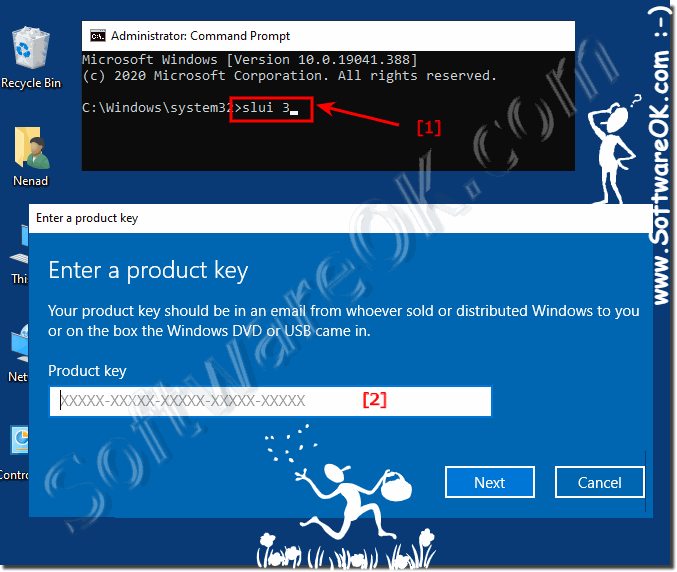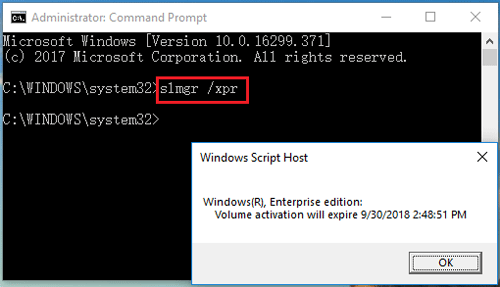Cmd Line Windows Activation
Choose Command prompt from accessories list. Right click on it select “Run as Administartor”. Another way to open command prompt in windows 7 is by going to the path C: Windows System32. Find cmd.exe file & right click to select ‘Run as Administrator’ option. Also read Way to know saved Wi-Fi Password in Windows 10. Steps to Activate Windows 7 Offline. Open Command prompt in Windows 7 by following as mention above.
- Command Line Windows Activation Windows 7
- Windows Activation Command Line
- Command Line Windows Activation Status
- Can we change product key in windows 10 after installing with one? Manually input windows 10 key via command line? Windows 10 pro product key was out of date i need new product key for product ID? Command line and product key for activation of windows 10 pro build 9600? Window 10 product keys confirmation id manual activation ghana?
- Hey, do you want to activate Windows 10 for free? I had been using Windows 10 for a year now but I had the annoying activation watermark. However, I found a super quick way to activate Windows 10 using CMD and no activation key is required.
- After you’ve logged into Windows Server Core, you’re presented with the Command Prompt. From there, you can activate your copy of Windows. First, you have to set the key. You do this with the Windows Server License Manager script, slmgr.vbs.
- To do so simply type in “cmd” or “command prompt” in your search box and then you will see the command prompt application appear. All you do is right-click on that application and “ Run as administrator “.
- How to activate Windows 10 Without any software using command prompt Windows 10 is by far the best operating system by Microsoft, it is easy to download and install, but when it comes to activating windows 10, it creates problem for the user to activate it and have access to many features.
Windows activation is designed to be as foolproof as possible, so Microsoft’s graphical tools keep it simple. If you want to do something more advanced like remove a product key, force an online activation, or extend the activation timer, you’ll need Slmgr.vbs.
This command line tool is included with Windows, and provides options unavailable in the standard activation interface provided on the Update & Security > Activation screen in the Settings app.
First: Open an Administrator Command Prompt Window
RELATED:How Does Windows Activation Work?
To use this tool, you’ll want to launch a Command Prompt with Administrator access. To do so on Windows 8 or 10, either right-click the Start button or press Windows+X. Click the “Command Prompt (Admin)” option in the menu that appears. On Windows 7, search the Start menu for “Command Prompt,” right-click it, and select “Run as Administrator.”
Note: If you see PowerShell instead of Command Prompt on the Power Users menu, that’s a switch that came about with the Creators Update for Windows 10. It’s very easy to switch back to showing the Command Prompt on the Power Users menu if you want, or you can give PowerShell a try. You can do pretty much everything in PowerShell that you can do in Command Prompt, plus a lot of other useful things.
View Activation, License, and Expiration Date Information
To display very basic license and activation information about the current system, run the following command. This command tells you the edition of Windows, part of the product key so you can identify it, and whether the system is activated.
To display more detailed license information–including the activation ID, installation ID, and other details–run the following command:
View the License Expiration Date
To display the expiration date of the current license, run the following command. This is only useful for Windows system activated from an organization’s KMS server, as retail licenses and multiple activation keys result in a perpetual license that won’t expire. If you haven’t provided a product key at all, it’ll give you an error message.
Uninstall the Product Key
You can remove the product key from your current Windows system with Slmgr. After you run the below command and restart your computer, the Windows system won’t have a product key and will be in an unactivated, unlicensed state.
If you installed Windows from a retail license and would like to use that license on another computer, this allows you to remove the license. It could also be useful if you’re giving that computer away to someone else. However, most Windows licenses are tied to the computer they came with–unless you purchased a boxed copy.
To remove uninstall the current product key, run the following command and then restart your computer:
Windows also stores the product key in the registry, as it’s sometimes necessary for the key to be in the registry when setting up the computer. If you’ve uninstalled the product key, you should run the below command to ensure it’s removed from the registry as well. This will ensure people who use the computer in the future can’t grab the product key.
Dec 01, 2018 Learn the steps how to add apps to Sharp Smart tv via AppsNow and VEWD Apps System. You can select option either AppsNOW or VEWD system for adding Sharp Smart Central apps on your Sharp Aquos Smart Tv. It helps you find the best videos and movies as per your interest. How to add apps to sharp 4k tv. Dec 26, 2017 Steps to download and install an application on your Sharp AQUOS Crystal 1. From the home screen, tap Play Store. Swipe left or right to the preferred sorting option. Scroll to and tap the preferred application.
Running this command alone won’t uninstall your product key. It’ll remove it from the registry so programs can’t access it from there, but your Windows system will remain licensed unless you run the above command to actually uninstall the product key. This option is really designed to prevent the key from being stolen by malware, if malware running on the current system gains access to the registry.
Set or Change the Product Key
You can use slmgr.vbs to enter a new product key. If the Windows system already has a product key, using the below command will silently replace the old product key with the one you provide.
Run the following command to replace the product key, replacing #####-#####-#####-#####-##### with the product key. The command will check the product key you enter to ensure it’s valid before using it. Microsoft advises you restart the computer after running this command.
You can also change your product key from the Activation screen in the Settings app, but this command lets you do it from the command line.
Activate Windows Online

To force Windows to attempt an online activation, run the following command. If you’re using a retail edition of Windows, this will force Windows to attempt online activation with Microsoft’s servers. If the system is set up to use a KMS activation server, it will instead attempt activation with the KMS server on the local network. This command can be useful if Windows didn’t activate due to a connection or server problem and you want to force it to retry.
Activate Windows Offline
Slmgr also allows you to perform an offline activation. To get an installation ID for offline activation, run the following command:
You’ll now need to get a a confirmation ID you can use to activate the system over the phone. Call the Microsoft Product Activation Center, provide the installation ID you received above, and you’ll be given an activation ID if everything checks out. This allows you to activate Windows systems without Internet connections.
To enter the confirmation ID you’ve received for offline activation, run the following command. Replace “ACTIVATIONID” with the activation ID you’ve received.
Once you’re done, you can use the slmgr.vbs /dli or slmgr.vbs /dlv commands to confirm you’re activated.
This can generally be done from the Activation screen in the Settings app if your PC isn’t activated–you don’t have to use the command if you’d rather use the graphical interface.
Extend the Activation Timer
RELATED:You Don’t Need a Product Key to Install and Use Windows 10
Some Windows systems provide a limited time where you can use them as free trials before entering a product key. For example, Windows 7 offers a 30-day trial period before it begins complaining at you. To extend this trial period and reset it back to 30 days remaining, you can use the following command.As Microsoft’s documentation puts it, this command “resets the activation timers.”
This command can only be used several times, so you can’t indefinitely extend the trial. The number of time it can be used depends on the “rearm count,” which you can view using the slmgr.vbs /dlv command. It seems different on different versions of Windows–it was three times on Windows 7, and it seems to be five times on Windows Server 2008 R2.
This no longer seems to work on Windows 10, which is very lenient if you don’t provide it a product key anyway. This option still works on older versions of Windows and may continue to work on other editions of Windows, such as Windows Server, in the future.

Command Line Windows Activation Windows 7
Slmgr.vbs Can Perform Actions on Remote Computers, Too
Slmgr normally performs the actions you specify on the current computer. However, you can also remotely administer computers on your network if you have access to them. For example, the first command below applies to the current computer, while the second one will be run on a remote computer. You’ll just need the computer’s name, username, and password.
Windows Activation Command Line
The Slmgr.vbs command has other options, which are useful for dealing with KMS activation and token-based activation. Consult Microsoft’s Slmgr.vbs documentation for more details.
READ NEXTCommand Line Windows Activation Status
- › How to Create a Local Account While Setting Up Windows 10
- › What Is Windows 10X, and How Is It Different?
- › How to Delete Apps on an iPhone or iPad With iOS 13
- › How to Merge Multiple Google Drive and Google Photos Accounts
- › How to Edit Any Web Page in Chrome (or Any Browser)